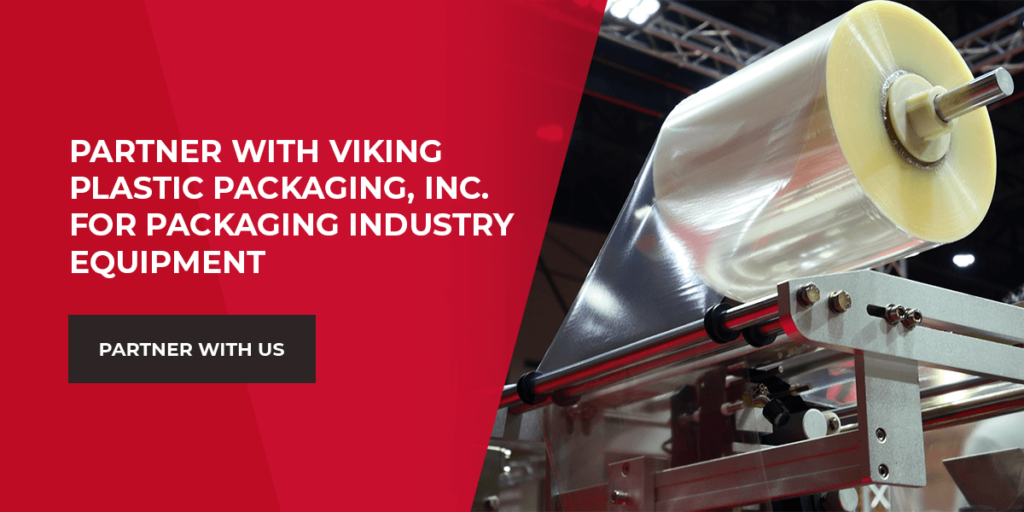Guide to Packaging Equipment
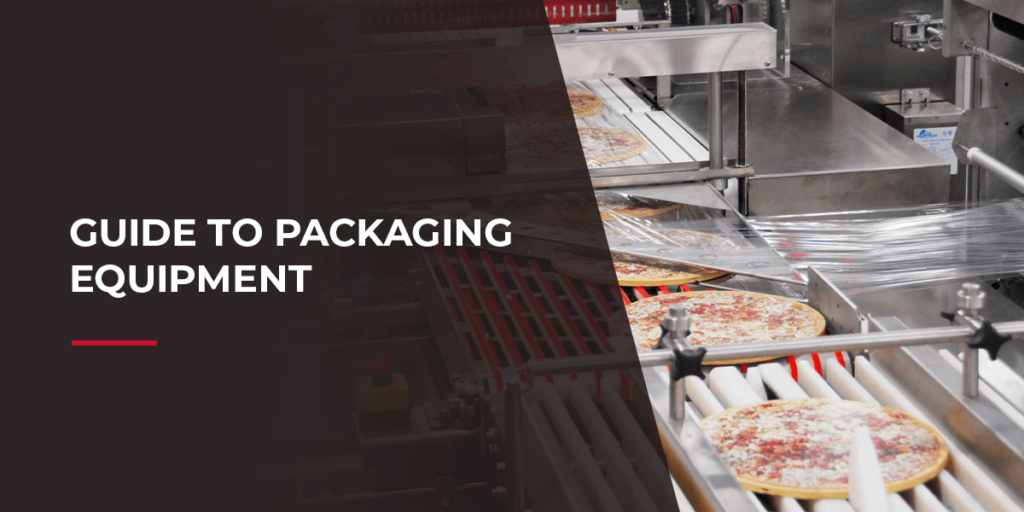
To achieve the ideal packaging for any product, businesses will typically use several types of packaging machines. Understanding what machines are required for your packaging process is only one part of choosing the right equipment for your facility. Knowing the role that each piece of equipment plays and how it benefits the process will aid in narrowing options for your packaging line. The complete guide to packaging machines below will help you determine what machine best fits your application.
What Machines Are Used for Packaging?
Before addressing the different types of packaging equipment, we need to understand the categories of machinery, which include:
- Machines for erecting trays, cases or boxes
- Filling machines for liquids and dry goods
- Case sealing machines
- Shrink wrapping machines
- Stretch wrapping
- Labeling equipment
- Palletizing machinery
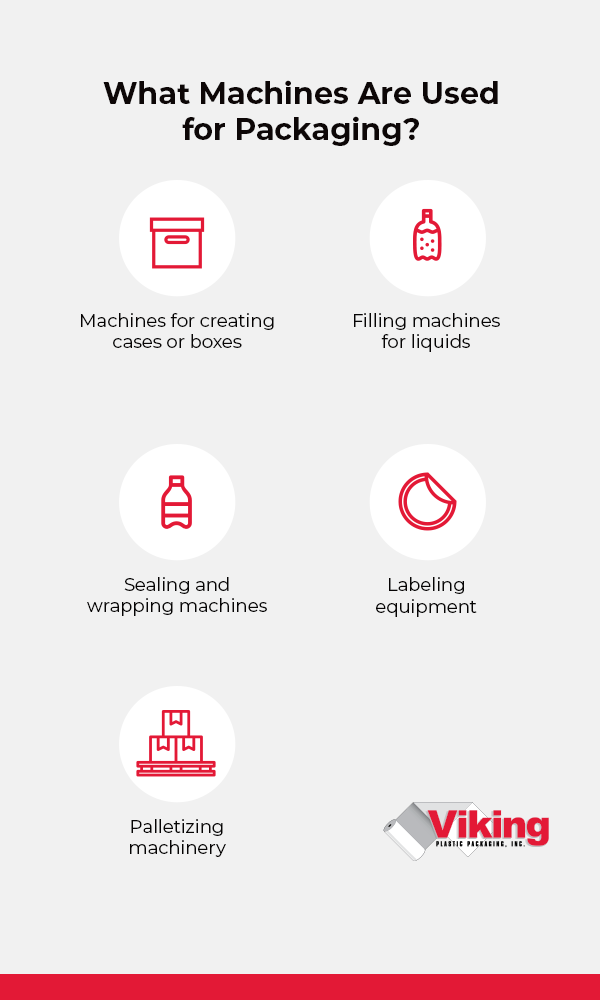
Each category has a range of machine types. Sealing or shrink-wrapping equipment fully encloses your product for protection and provides a great shelf appearance. Case erectors create a vessel to pack those shrink-wrapped products into. Case sealers help you consistently close the cases while offering predictable, efficient tape usage. Palletization and stretch wrappers help limit the amount of labor needed to stack and wrap pallets at the end of the line. These options help limit and reduce workplace injuries.
Machines work together to complete the packaging process. Filling machines add liquid to bottles, labeling machines add codes or labels to containers and shrink bundling machines hold the bottles on the tray by sealing and shrinking the flat of drinks.
Throughout the process, each piece of equipment must meet the demands of output required of a facility while fitting into the budgetary needs of the company. When considering machinery, look at the materials used, work capacity, speed and maintenance requirements. These packaging machine comparisons will make choosing the best types of packaging equipment for a packaging line possible.
The most common packaging machines include the following:
Stretch Wrappers
Hand wrapping pallets is an inexpensive option, but this method does not allow for the most efficient use of wrap or the best containment of the pallet load due to weaker, inconsistent coverings. Automatic and semiautomatic operations increase the speed of the wrapping and tension of the plastic consistently.
These wrappers may rank as the most important packaging machines because they perform a critical safety task — securing pallet loads before shipping. Properly wrapped pallets will not lose products or fall apart during shipping. This secure load containment protects everyone who interacts with or around the pallet by preventing products from falling off and causing injuries or damage. One of the biggest benefits of automating your stretch-wrapping process is damage reduction. Product damage during shipment amounts to about $1 billion a year in damage losses in the United States alone.
There are multiple types of stretch wrappers:
- Turntable: Turntable wrappers hold the wrapping material in place while the pallet spins on a turntable. The wrap typically covers the load from the bottom to the top as the turntable spins. A conveyor can be integrated with these wrappers to fully automate the process. Some models, such as the Q Automatic, can wrap between 45 and 60 pallets per hour.
- Straddle: Straddle wrappers keep the load still while the wrapping rotates around it to cover the pallet. This option better serves unstable loads that could lose materials while turning on a turntable. Fully automated versions of the straddle wrapper, such as the S-3500 Stretch Wrapper, use a conveyor and can wrap up to 90 pallets per hour.
- Ring straddle: Ring straddle pallet wrappers have a similar operation as straddle wrappers. Both hold the load while the wrapping delivery arm turns around the load. What sets ring straddle wrappers apart is the piston on the delivery arm that moves the pallet vertically as the wrapping moves around it. These wrappers operate extremely quickly. For example, the RL Automatic model can wrap up to 180 loads per hour, depending on height. Ring straddle wrappers are specialized options typically used in beverage or toiletry industries.
- Orbital: Orbital stretch wrappers secure unusually shaped loads onto pallets by wrapping plastic over and under the load. A conveyor moves the load through the wrapper to automate the process.
Shrink Sealers
Shrink sealers place your product in a shrink film, a polymer-based material from a family known as polyolefins. These machines utilize a variety of heated seal systems to seal the bag on all sides before sending it to the heat tunnel to shrink the bag and improve clarity and stability.
Sealers have several common forms:
- L-bar: L-bar sealers are often manual machines that have sealing arms that resemble the letter L for both sides of the product. Automatic L-bar sealers are also available, such as the Texwrap 2219. These machines are best suited for small to medium volumes of sealing work and when the shelf appearance of the product through the film is important. With an easy-to-use design, this sealer requires little training and maintenance.
- Side: Side sealers are best suited for operations that require flexibility to seal a range of product sizes and configurations. Side seal machines typically are faster than L-bar equipment and are not limited in seal length.
- Lap: Lap sealers don’t produce scrap and are best for companies that need to minimize waste. Since they don’t produce waste, these systems are more efficient and can cut down shrink film costs. Lap sealers, however, require equipment changes between products of different dimensions, making them best for mass-produced products. The consistent size of products passing through this system allows for high-speed sealing. For example, the STB-145LS has a conveyor speed of up to 200 feet per minute. Intuitive, easily accessible controls also contribute to efficiency.
Shrink Tunnels
Shrink tunnels heat shrink wrap for bundling or wrapping. Bundling serves a functional purpose by holding together multiple products in a single case or package. On the other hand, shrink wrap tunnels use thinner film for better aesthetic results of individual products or small multipacks.
Bundling tunnels frequently appear in the food and beverage industry to package cases of bottled drinks or cans of food. Due to their use for securing larger packages, bundling tunnels have larger openings to accommodate the bigger cases that pass through them. Bundlers often work with durable polyethylene film, such as the Performance Series Bundling Tunnels.
Shrink wrap tunnels have smaller openings because they handle individual or small groups of products. They also typically accommodate multiple types of polyolefin films that are often thinner than those used for bundling.
Shrink tunnels can have one, two or three chambers, as in the case of the 1322, 1322-2 and 1322-3 models of shrink tunnel. The single chamber tunnel works best for lower volume or lower speed wrapping, while multiple chambers accommodate faster applications. These tunnels typically follow the work of shrink sealers, heating the film so it form-fits around the product for a tight seal.
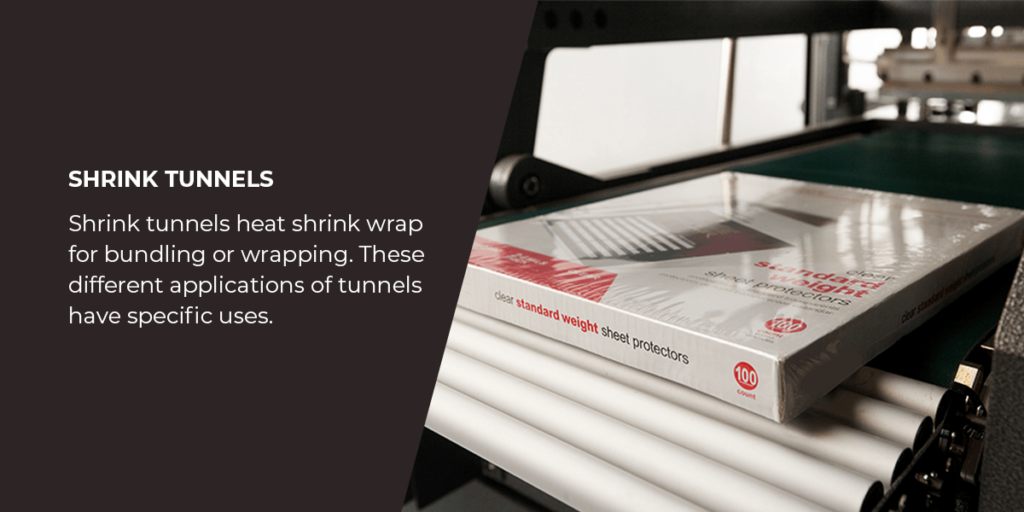
Case Erectors
Case erectors save workers the tedious manual task of unfolding, setting up and taping cardboard boxes. These come in several levels of automation, depending on the number of cases needed and the speed of packaging required.
Semiautomatic case erectors require some manual input from a worker. Some machines may combine multiple tasks such as construction and sealing. One semiautomatic case erector that also automatically seals is the BEL 5252U. This unit allows large cases — longer than 22 inches — to have their flaps folded by the operator instead of automatically folded by switching the unit to semiautomatic mode. With a single button push, the case erector accommodates larger containers easily for enhanced versatility in carton sizes.
Fully automatic case erectors maximize productivity by producing a high volume of boxes quickly by forming, folding and sealing the bottoms of cases. These machines work effortlessly without operator input, allowing more box production with fewer employees on the floor.
With single case dimension production, automatic case erectors work best for facilities that require only a small number of different case sizes. One type of automatic case erector is the ERX-15, which can produce up to 15 cases per minute. Changeovers for different sizes of cases do not require additional tools, just five steps for the adjustment.
Case erectors with the flexibility of semiautomatic operation or the speed of fully automatic production save time over manual case formation and bottom sealing, reducing wasted time, reducing inconsistencies and keeping production moving forward.
Case Sealers
Case sealers seal packed boxes and come in semiautomatic and fully automatic systems. The semiautomatic options typically require the operator to insert cases and fold flaps before the device seals the containers. Semiautomatic sealers adapt readily to different case sizes with minimal adjustments. For instance, the BEL 150 only requires a two-point toolless case change for rapid shifts to different case sizes.
Fully automatic case sealers come in uniform and random variations. Uniform models work quickly to seal cases of the same dimensions. The SB-2EX AUTO model automatically folds all the flaps and seals the top and bottom of uniform-sized cartons that move into it down a powered conveyor belt. An operator can easily make adjustments to change the sizes of cartons that move into this sealer and seal up to 20 cases a minute.
Case sealers often integrate with other parts of a packaging line. For instance, they can be integrated with form/pack/seal systems that form cases, fill them and seal them closed. Integrated equipment reduces the time needed for the filling and packaging of products.
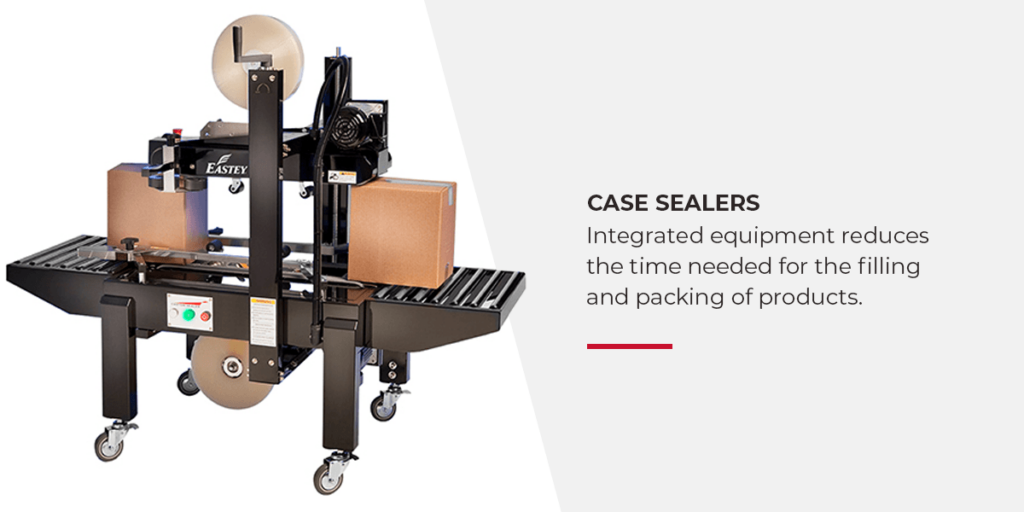
Laser Coders and Applicators
Coders and applicators apply important information onto packages or products. The methods used vary among these tools, with the best option for production depending on the product and data needed.
Laser coders add information directly to packages or products without needing ink. These machines offer low downtime and minimal maintenance. They also do not require labels or other consumables for operation. Laser coders are versatile. The SQ-50F, for instance, can create permanent codes onto rubber, matte metals, plastics, ceramics and composite materials.
Label printer applicators (LPAs) print labels and apply them directly onto the products. Both barcodes and product information can fit onto the printed labels LPAs apply. Depending on the model, these systems may use direct thermal or thermal transfer printing (TTO) methods that utilize ribbons. All labels are pressure sensitive and only require gentle pressing onto the products after printing.
Label applicators use pre-printed, pressure-sensitive labels and apply them to the products. Some models offer wrap-around applications for jars or bottles, such as the ELF-50, while others apply flat labels, such as the Alpha HSM label applicator.
These coders and applicators allow for adding branded images, product information, barcodes and other vital data onto the exterior of product packages for both scanners and people to use.
Inkjet Printers
Like laser coders, inkjet printers allow you to print information directly onto the product or package without the need for labels. You can choose from many different types of ink — like those made with solvent, water or oil and those that cure under ultraviolet light — to find the one that best suits your application.
This kind of printing can impart colorful, custom designs onto a wide range of materials, like plastics, metal, glass, paper, wood and fabric. Inkjet printing delivers a professional, high-quality image and can be used for everything from product graphics to time stamps and barcodes. Inkjet printers are cost-effective, low-maintenance and efficient, with minimal setup time and easy changeover.
Bagging Equipment
Automatic bagging and sealing equipment increase product packaging speed while protecting goods from damage. Fully automated bagging equipment, such as models from the Sharp Automated Bagging System, uses bags that open easily inside the machine for quick filling and sealing in an all-in-one system. Automating the bagging process helps free up your employees to do less manual work, making your operations more efficient.
Partner With Viking Plastic Packaging, Inc. for Packaging Industry Equipment
Since 1967, Viking Plastic Packaging, Inc. has served as an end-to-end solution creator and leader in the packaging industry. We work with our customers to find the best solutions for their packaging equipment to suit their company’s needs. We optimize packaging equipment to produce professional, efficient and reliable results.
Our premium materials, expert technicians and high-quality equipment give our customers the edge they need to consistently and efficiently package their products. Combined, our team of expert technicians has more than a century of experience they use to help our customers with their troubleshooting, repairs, packaging line integrations, upgrades, training and installation. Learn more about partnering with us at Viking Plastic Packaging, Inc. today.
